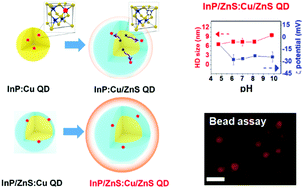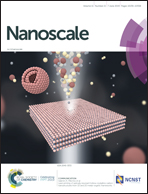Synthesis of far-red- and near-infrared-emitting Cu-doped InP/ZnS (core/shell) quantum dots with controlled doping steps and their surface functionalization for bioconjugation†
Abstract
In this study, we designed and synthesized far-red- and near-infrared-emitting Cu-doped InP-based quantum dots (QDs), and we also demonstrated their highly specific and sensitive biological imaging ability. Cu-doped InP/ZnS (core/shell) QDs were prepared using the hot colloidal synthesis method in the organic phase. The ZnS shell passivates the surface and improves the photoluminescence (PL) intensity. However, the InP : Cu/ZnS (core : dopants/shell) QDs, which were obtained after the Cu dopant was incorporated into bare InP QDs, followed by ZnS shell coating, had relatively low PL intensities (maximum PL quantum yield (QY) was only ∼16%) presumably due to the formation of defect sites in the InP-core QDs caused by dopant migration from the InP core to the ZnS shell. We prepared high-quality InP/ZnS : Cu/ZnS (core/shell : dopant/outer-shell) QDs, where thin ZnS shell layers were grown on bare InP QDs prior to Cu ion doping to prevent dopant migration and obtained PL QYs as high as 40%. The native hydrophobic ligands of the as-synthesized Cu-doped QDs were replaced with hydrophilic ligands including dihydrolipoic acid and a zwitterionic ligand, which rendered the QDs water-soluble. These QDs exhibited remarkable colloidal stabilities over a wide pH range, with hydrodynamic diameters less than 10 nm. Modified QD surfaces can also be used in conjugation with other functional moieties to apply highly specific and sensitive imaging probes with very low background levels. As a proof-of-concept study, we successfully demonstrated the selective imaging of streptavidin beads with biotin-conjugated QDs. These decorated Cu-doped InP/ZnS (core/shell) QDs are promising biological-probe candidates for imaging and assaying with reduced concerns regarding toxicity.



 Please wait while we load your content...
Please wait while we load your content...